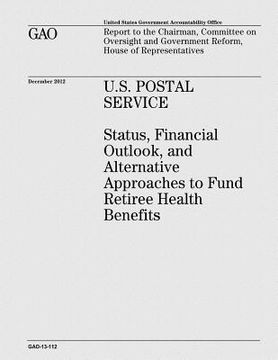U.S. Postal Service: Status, Financial Outlook, and Alternative Approaches to Fund Retiree Health Benefits (en Inglés)
Reseña del libro "U.S. Postal Service: Status, Financial Outlook, and Alternative Approaches to Fund Retiree Health Benefits (en Inglés)"
The Postal Service Retiree Health Benefits Fund (PSRHBF) covered about 49 percent of the U.S. Postal Service's (USPS) $94 billion retiree health benefit liability at fiscal year-end 2012. USPS's deteriorating financial outlook, however, will make it difficult to continue the current prefunding schedule in the short term, and possibly to fully fund the remaining $48 billion unfunded liability over the remaining 44 years of the schedule on which the 2006 Postal Accountability and Enhancement Act (PAEA) was based. The liability covers the projected benefits for about 471,000 current postal retirees and a portion of the projected benefits for about 528,000 current employees; it does not cover employees not yet hired. Under PAEA, USPS is responsible for contributing an additional $33.9 billion to the PSRHBF by fiscal year 2017, including the $11.1 billion USPS has defaulted on over the past 2 years. PAEA also requires the Office of Personnel Management (OPM) to calculate the remaining unfunded liability in 2017 and develop an initial 40-year amortization payment schedule. USPS, however, projects further declines in mail volume and revenues that may continue to limit its ability to prefund the remaining retiree health benefit liability. GAO's analysis of maintaining current law requirements compared to five alternative approaches showed differing impacts on USPS's future annual payments and unfunded liabilities. For example, three of the approaches--1) the Administration's Approach, 2) Senate Bill (S. 1789) and 3) "Pay-as-You-Go" (no prefunding)--would reduce USPS's annual payments in the short term, thereby easing its immediate cash flow problems and financial losses. However, these approaches would increase USPS's unfunded liability, sometimes substantially, and require larger payments later. Deferring funding could increase costs for future ratepayers and increase the possibility that USPS may not be able to pay for some or all of its liability. Conversely, a fourth approach--the House Bill (H.R. 2309)--and the current law requirement would reduce USPS's unfunded liabilities more aggressively but may result in significantly higher USPS financial losses in the near future. If USPS stopped prefunding and let the existing fund grow with interest, the unfunded liability is projected to significantly increase. Under a fifth approach, if USPS stopped prefunding and used the existing fund to pay current and future premiums, the fund is projected to be exhausted by 2026. Private sector, state, local, and other federal entities are not required to prefund these benefits, though some do so to a limited extent, and most are required to recognize the future costs in their financial reporting. GAO identified several key considerations including: (1) the rationale and consequences of prefunding such benefits; (2) trade-offs affecting USPS's financial condition, such as sizes of the annual payments and unfunded liability; (3) fixed versus actuarially determined payments; (4) targeted funding levels; and (5) assumption criteria. USPS is intended to be a self-sustaining entity funded almost entirely by postal ratepayers, but its financial losses are challenging its sustainability. GAO has testified that USPS should prefund its retiree health benefit liabilities to the maximum extent that its finances permit, but none of the funding approaches may be viable unless USPS has the ability to make the payments. USPS's default on its last two required PSRHBF payments and its inability to borrow further make the need for a comprehensive package of actions to achieve sustainable financial viability even more urgent.

